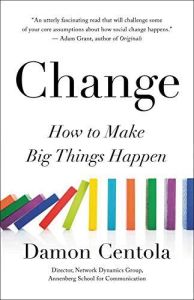Acesse a sua conta getAbstract para obter o resumo!

Acesse a sua conta getAbstract para obter o resumo!
Damon Centola
Change
How to Make Big Things Happen
Little, Brown Spark, 2021
Sobre o que é?
To change the world, change how you use your social network.
Recommendation
Social scientist and communications professor Damon Centola explains the common errors in the way most people think about messaging and influence. Social media provides researchers with unprecedented access to granular data on how social change and innovation propagate through networks, and one major finding is that they don’t spread primarily through celebrities or influencers. Instead, social change relies on mutual support systems that emerge from small communities on the periphery of networks. The way people connect then shapes how they accept – or don’t accept – new social norms, ideas and products.
Summary
About the Author
Damon Centola is Elihu Katz Professor of Communication, Sociology and Engineering in the Annenberg School for Communication at the University of Pennsylvania, where he also leads the Network Dynamics Group.























Comment on this summary